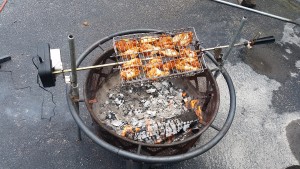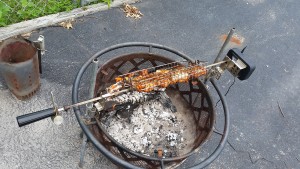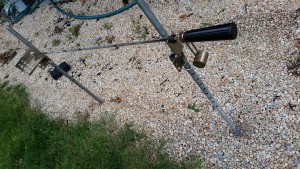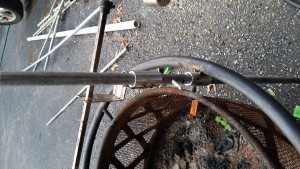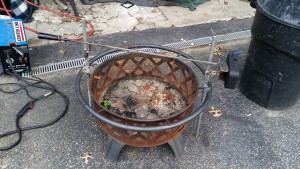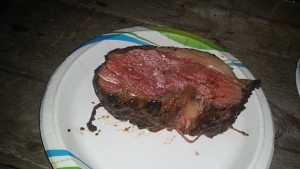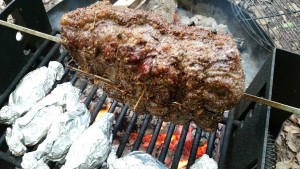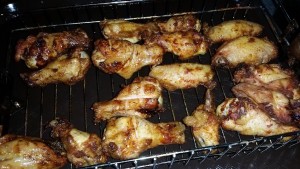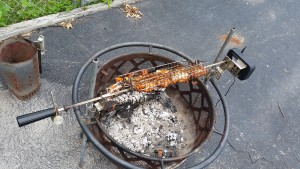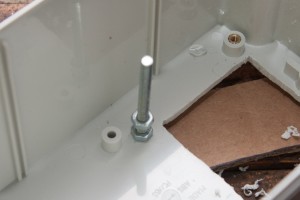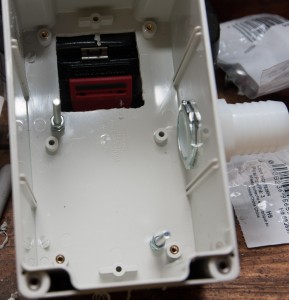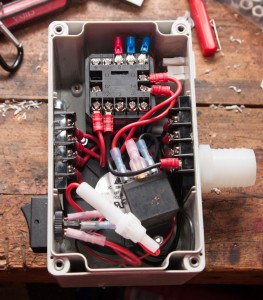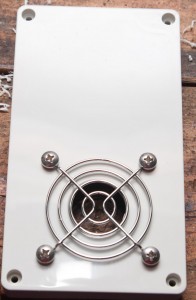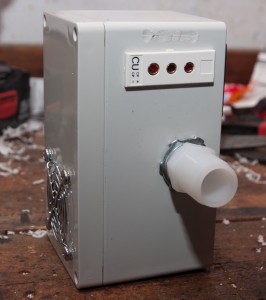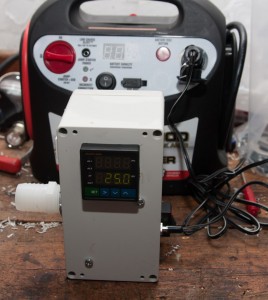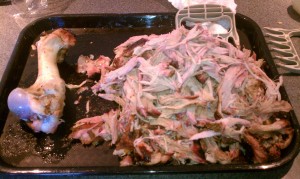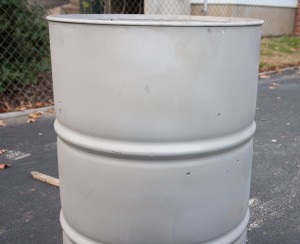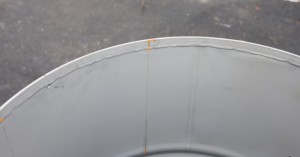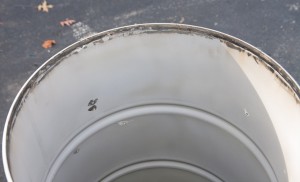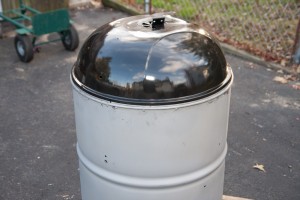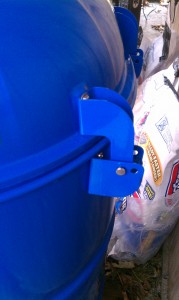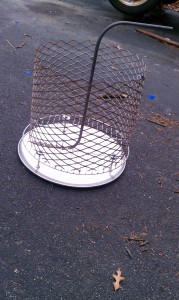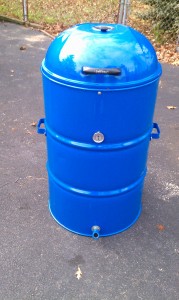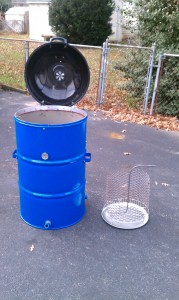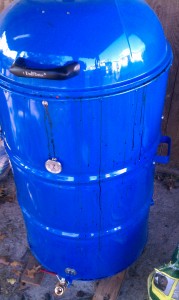Seth's House
Campfire / Open Fire Rotisserie Setup
(Inspiration from this thread, and BBQ Brethren member Larred)
Ever since I built a UDS (and scored a CG Akorn for $89 🙂 ) , my poor CG Smokin’ Pro gets little to no use. The only real cooking it sees is for the rotisserie setup, which is the stock CG rotisserie kit.
After seeing the thread linked above on BBQ Brethren, I realized I could easily adapt my existing rotisserie gear to any fire,with very little effort. I went ahead and purchased an extra mount kit, took out my crappy Harbor Freight welder, and got to work.
The pieces are simple — I put it all together by walking around Lowes and fitting things together.
1) Rebar, to drive into the ground and hold the rods that the brackets attach to
2) Rods, the bracket attach to these. I used some leftover electrical conduit that I laying around. I drilled holes every inch or so, for height adjustment. Used some pins I had laying around for height.
3) Steel bushings, from Lowe’s. You’ll find these in the area that has all of the screws, nuts, bolts, etc..
4) Rotisserie spit rod bushing (as the rods will not always be the same distance apart, I have to be able to adjust. The stock one on my spit doesn’t move any more because it’s old.
(note, this welder sucks, and I’m not the greatest welder, so, the welds are not pretty. I know. I don’t care).
Pretty simple after that — I just welded the bushings on to the brackets, drilled some holes in the rods for height adjustment, and voila. Make sure you aren’t stupid like me, and you weld the bushings off to the side of the brackets. If you weld them down the middle, then the rotisserie spit rod will hit the support rod.
Pretty simple set up — you should be able to duplicate easily. Thanks for visiting!
We took a whole New York Strip loin, trussed it up, and stuck it on the rotisserie. Amazing!! We did it twice.. the pics are from the first time. The second one, we put the fire closer to the steaks — that fat layer completely rendered out.
DIY 12 Volt PID Smoker Controller
While my last PID controller build is extremely versatile and a multi-tasker, the only drawback is that it requires AC power to operate. I recently put together an Ugly Drum Smoker, which unlike my CharGriller, is (somewhat) portable. The need came up for me to build a PID + blower fan rig that could be powered from AC, but also portable power if necessary. Luckily for me, the JLD612 comes in a 12 volt model, and with a background in car electronics, this 12-volt setup was a cake walk. This particular build is not a multi-tasker, just a straight up smoker controller.
While at home, I can power it with a standard 12 volt wall wart power supply, and when on the go, I can use a jump pack, or even a car battery and some alligator clips.
Just like anything I post, this is the way *I* built this unit. Is it the only way to do it? Nope. Is it the absolute best? Probably not. But it works for me, and should give you, the reader, enough information to help you figure out something on your own.
Parts List
Here are the parts I used for my build – many have “See Power Input Notes below” because you can pick and choose whatever type of physical input power connector you wish.. this is just what I ended up with myself. There are infinite choices, many better ones than I have used, you’re free to do what you wish.
- 1x JLD-612 (12 Volt Model) PID Temperature Controller – $36.50 US
- 1x Digikey P/N 603-1177-ND 15.3CFM 12V Blower Fan – $15.53 US
- 1x Digikey P/N HM923-ND Project Box – $15.13 US
- (See Power Input Notes below) 1x Digikey P/N T1061-P5P-ND 12volt Power Supply – Size M Connector- $14.70 US
- 1x PT100 Sensor Probe – $15.50 US
- 1x TPJ-U-F thermocouple panel jack – $4.70 US
- 1x OTP-U-M thermocouple male plug – $3.90 US
- (See Power Input Notes below) 1x Digikey P/N SC-1047-ND *OR* Radio Shack 274-1563 Size ‘M’ Panel Connector ~$4 US
- (See Power Input Notes Below) 1x DigiKey P/N 763KSW-ND *OR* Radio Shack 274-1569 Size ‘M’ DC Power Plug ~$4 US
- (See Power Input Notes Below) 1x 12 Volt SPST Switch (optional – have a look at Digikey’s catalog or a Radio Shack Example that I used) ~$4 US
- Standard Automotive 12 volt relay (something like this) – ~$5 US at any Auto Parts store, I had some laying around
- (Optional) 2x Barrier strips, at least 3 positions – like these – don’t forget the jumpers
- 1″ ID x 3/4″ MIP Nylon Hose Barb (Home Depot part A-625 in the nylon hose part area)
- Hose to connect to your smoker – I used 1″ ID plastic bilge hose from Home Depot
- (Optional) 1x Warning light, 12volt powered, if you plan on using the built in alarm functions of the JLD612
- 1x Fan guard, salvaged from parts laying around. Digikey’s fan guard section
- 1x Fuse holder Example 1 Example 2 – along with a 1amp 12 volt fuse
- M4 nuts and bolts to mount the fan
- Various quick disconnect crimp connectors. If you have a well stocked electrical connector box for automotive stuff, that will get you through it
- Hot glue gun to mount components like the barrier strips
- Dremel tool / drill, to mount everything in the box
Power Input Notes
I chose to use a wall wart for my 12 volt power source (when AC is available), and also put an on/off switch for the whole unit. You don’t need to use either, but you can if you want. I actually bought the wall wart, but, if you go digging in your junk pile at your residence, you will probably find a 12V power supply that works just fine for you from an old phone or router. You may also decide to use this away from any type of power source ever, and just use a 12 Volt battery or jump starting pack (my whole reason for building a 12 volt PID in the first place) – in that case, pick whatever type of physical power input plug works for you. Digikey and Radio Shack have extensive choices, have fun with their catalogs.
Relay Talk
The JLD612 has two different methods of activating the heating device, in our case, a blower fan. It can use the built-in relay J2, or it can use the built in SSR (solid state relay) control. Since I had relays laying around, my build uses the J2 option. If you want to use an SSR, by all means, go right ahead. Sample units are here and here. The advantage of using an SSR is that you could use the built in alarm functions of the JLD612 to activate warning lights (anything, really) on low or high temperature conditions, while using the SSR output for the PID control. In my setup, J2 is tied up with PID control, so only J1 is available for alarm output.
Fan Output – Rectangle in to a round hole?
When I first envisioned this thing, my only real question without having the parts in my hand was if the rectangular output of the fan would mate up to the circular hose barb – more importantly, if I would have to block off the air from the fan exit so that it would only blow out of the hose barb, and not just blow inside the project box. The answer is, no, I did not have to block off any of the fan exit. When I mounted everything, I lined it up as best I could, and plenty of air comes out of the barb without any sort of special ductwork. I am actually impressed at the amount of air that this fan moves.
Component Mounting
I mounted the JLD612 and thermocouple jack first. Make templates with cardboard for the JLD612 and thermocouple panel jack. Transfer these templates to the plastic project box and start cutting. My JLD612 is mounted high on the box as far as I can go, while still being able to attach the wire terminals for pins 6-10 on the JLD612, and leaves enough space for the fan to fit in the box.
Once the JLD612 is in place, I worked on mounting the hose barb, which is the fan output. I first placed the fan in the box and mounted it as high as I could without interfering with the JLD612, but also clearing the plastic ridge inside the box. I then marked its two mounting holes and drilled holes in the plastic box. Using a 2″ M4 machine screw, I secured the screw through the box, with a nut on the inside. I then added 1 nut to each screw, so the fan stood off of the box by about a 1/4″ (eyeballed). Once the fan was mounted, I marked the center location of the fan output, and drilled the hole for the hose barb. Mount the hose barb with the conduit nuts, then adjust the location of the fan so that it is centered in the host barb opening. Once it’s centered, add another nut to each screw to hold the fan securely.
The switch, warning light, and power input jack all mount through drilled holes. The relay inside mounts on one of the fan screw posts with a nut, just so it’s not bouncing around.
Wiring
- Input voltage comes in through the M connector. Negative (aka ground in the 12V world) goes straight to the Negative Barrier Strip. +12v goes through the switch, to the fuse holder, then to the +12V Barrier Strip.
- Supply +12V from barrier strip to the JLD612 on pins 1, 4*, 13, and the relay pin 30
- Supply -12V from barrier strip to the JLD612 pin 2, Relay pin 85, fan negative, warning light negative*, and your switch if you chose a lighted one
- Connect the red pin of your thermocouple to pin 8 of the JLD612 (through panel jack)
- Connect each blue pin of your thermocouple to pin 9 and 10 of the JLD612 (through panel jack)
- Connect pin 14 of the JLD612 to pin 86 of the relay
- Connect pin 87 of the relay to the fan positive input
- Connect pin 5 of the JLD612 to your warning light +12v*
*Warning light not pictured at the time of writing this
That’s about it as far as construction goes! You will want to familiarize yourself with the PID controller manual and set all of the configuration parameters properly on the first use. My settings are as follows on the ‘0089’ set menu:
- IntY = PT 10 0 (Pt100 thermocouple, this setting will show temp in .1 increments)
- OutY = 1 (PID controls J2 )
- rd = 0 (heating control)
- CorF = 1 (Fahrenheit)
On the ‘0001’ set menu, I have the following settings, for the high temperature warning light to come on at 230F and go out at 228F:
- AH1 = 230
- AL1 = 228
On the ‘0036’ set menu, I have the following setting due to me using a mechanical relay. For an SSR, leave this alone:
- ot = 5 (Recommended to use 5-15, TBD what setting I end up with. This keeps the relay from cycling so much and wearing out)
Ugly Drum Smoker (UDS) Build
While my CharGriller Smokin’ Pro has done me right over the years, I wanted to build another smoker with more capacity. Originally, I was going to build an offset smoker with a 55 gallon drum. Once I started researching that, I came across plans for an Ugly Drum Smoker, and after a ton of reading, decided to go that route.
My plans were based off all of the reading in the BBQ-Brethern.com thread, as well as the plans from this site. All the credit goes to them.. I didn’t invent anything, I just did a lot of reading and followed recommendations.
Upon setting out, I knew I wanted two things out of this.
- Two cooking grates (twice the cooking area 🙂 ). That means I had to use a dome lid
- PID control -done, see here
For #1, many folks take the lid off of a Weber 22.5″ grill, which fits directly on a 55 gallon drum without any modification. I wasn’t about to drop a bunch of coin just to get a lid, and I don’t need another grill, so I found an alternative. This Uniflame 22.5″ Grill from Walmart has a lid that will fit a 55 gallon drum with a tiny modification – see Thread 1 or Thread 2. Bonus – the grill was on clearance at Walmart, I picked a few of them up for $20 a piece.
The Build
I have friends in the auto industry, and they in turn have access to 55 gallon drums. My cost on the drum was 0, but you can find them in the Philly area quite easily for about $25 if you look on Craigslist.
I also have friends with a Powdercoating business, so I was able to get a quality powdercoating job on the entire outside of the drum done in a nice, bright blue, without breaking the bank. I could have painted the drum like most people, but the powdercoating came out AWESOME and it will last for years to come.
Check out Precision Powdercoating, that’s where I had the drum done. Tell them I sent you!
Anyways ..
First I had the drum completely sandblasted. This is also a requirement before powdercoating, so I probably did not need to get this done twice. In the following pictures, the gray color is the bare metal of the drum after sandblasting.
First step before painting or powdercoating is to make all of the necessary holes and modifications to the drum.
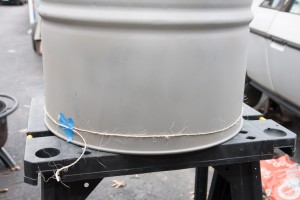
Marking the 3 air inlet holes
I tied a string around the drum, took it off, marked it off in thirds, transferred the marks to the drum and drilled.
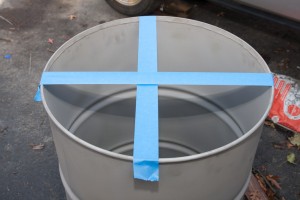
I used tape to mark center lines across the top of the drum.
Once I had even marks around, I made my holes for mounting the grate holder bolts, thermometer, handles, and thermocouple.
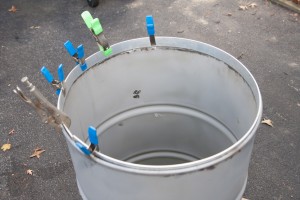
To make the Uniflame lid fit snugly, I took some 1/8″ thick 1 1/2″ aluminum flat bar, bent it around the inside of the lip, then riveted it into place.
Start at one end, place rivets about every 6 inches. Trim the flat bar once you are at the very end (and don’t cut it too short like I did, otherwise you have to fill a gap)
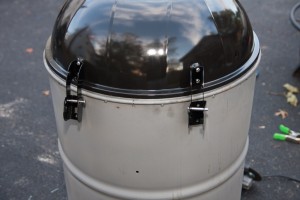
I used the hinge hardware that came with the Uniflame grill, and attached it to the UDS.
The only modifications to the hinges that were necessary was to make new holes for the pins to go through .. easy work with a drill.
Once all of the holes were done, I disassembled everything and sent the drum out for powdercoat (outside of the drum only!). Once it came back, I mounted all of the hardware up, using stainless hardware. To seal the drum well, you should use high temp RTV around each and every fastener from the inside of the drum (yes, it is food safe). I didn’t do this step, and I had a ton of oil leak out of each and every fastener hole, staining my fresh powdercoat job 🙁 Seal the aluminum lip for the lid, from the bottom of the lip inside the drum, to keep air from leaking out. I used a flashlight place inside the drum, facing up at my face, to see the air gaps and make sure I sealed it properly.
For the charcoal basket, I used the charcoal grate from the Uniflame grill, and expanded steel. I bent the expanded steel around a propane tank to get the basic shape, then welded it to the grate and itself, forming a cylinder. I then took a cheap $5 aluminum pizza pan from Walmart to use as an ash pan, using stainless 3″ bolts to offset it from the rest of the basket.
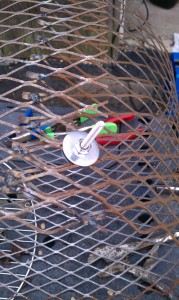
Used nuts and bolts to hold the steel together while I welded it. (p.s. my welding skills suck, I know!)
That’s about it! Along with my 12v PID controller, the UDS has proven to be quite awesome!
More pics:
